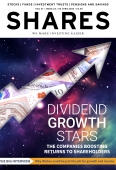Archived article
Please note that tax, investment, pension and ISA rules can change and the information and any views contained in this article may now be inaccurate.
Can the DAX’s performance continue to lure people away from US shares?

There is a growing divide between the US and Europe from an investment perspective, even though all markets apart from Switzerland have fully recovered from the Liberation Day-triggered sell-off in April.
One might have thought the bounce-back in American shares would have stopped the great rotation away from US assets that we’ve seen since Trump returned to the White House. However, the recovery in share prices doesn’t change the fact that we’re potentially seeing one of the biggest shifts in investor thinking for decades.
Few investors are going to give up on the US completely, particularly as it has been responsible for such great returns in the past. Instead, we’re seeing greater realisation that it’s wrong to be overly reliant on one part of the world for wealth creation.
WAKE-UP CALL TO BE GEOGRAPHICALLY DIVERSIFIED
Donald Trump has done investors a favour, even though certain individuals don’t realise it. When US markets were racing ahead, few people wanted to hear the argument about American stocks being overly expensive. Why spoil the party when there was still fun going on? Well, Trump’s trade policies not only brought the party to an end, but they’ve also provided an important wake-up call for investors to be more diversified.
Faced with the prospect of an economic wobble in the US, a government with swelling debt, and a country that has lost its triple-A credit rating (Moody’s downgraded the rating earlier in May), it’s not hard to see why US investment appetite has waned.
The US Federal debt currently stands at $36 trillion, and Congressional Budget Office estimates expect another $22 trillion on top by 2036. Half of the publicly held treasuries, or in the region of $14 trillion, will mature and need to be refinanced, and that will entail higher coupons and interest rates than current maturities. That’s why the market is watching the bond market so closely, to see if or when treasury yields prove sufficiently tempting that they persuade investors to take less risk, buy US government bonds and dump US equities.
GERMANY’S KNOCKOUT PERFORMANCE
With significant headwinds for the US equity market, it’s no wonder there is growing talk of investors already looking elsewhere. So, where is the money flowing now?
The natural place to hunt is where there are cheap opportunities such as Europe. Germany’s DAX index is the star performer year-to-date, up 21% between 1 January and 21 May 2025.
Germany has stood out from the crowd because of its decision to ramp up spending on defence and infrastructure, creating a tailwind for various companies in the DAX index. With so much uncertainty around tariffs, it’s understandable why investors have gravitated towards a part of the world still able to offer solid earnings growth potential.
The key unknown is whether this rally can continue. The DAX is now trading at its most expensive level in four years at 15 times next 12 months’ earnings. While that is still cheap relative to the US (the S&P 500 is on 21.4 times forward earnings), it’s no longer the bargain that the German index used to be. The market has priced in so much good news which means you have to ask what else will drive the index upwards.
There’s always a risk that investors bank profits on German equities and reallocate the proceeds to the US, particularly if they decide they cannot give up their addiction to Wall Street. However, Trump’s trade war is still rumbling on and until there is full clarity post-trade deal negotiations, certain investors might decide to hedge their bets and keep money invested in various parts of the world rather than going all-in on the US again.
ONE AREA OF THE FUNDS MARKET IS RED HOT
Seeking broad geographic exposure has long been popular, but specifically looking for global opportunities excluding the US is more of a recent phenomenon. Investors put $2.5 billion into world equity funds that exclude US exposure between the start of December 2024 and the end of April 2025, according to an article in the Financial Times citing data from Morningstar. The bulk of the inflows came in the past three months, and it reverses a trend that saw three years of net withdrawals for world ex-US funds.
The MSCI World ex-US index is having its moment in the sun after a laggard performance. Over the past decade, it has generated half the total returns (+76%) compared to the broader MSCI World index (+151%). The tables have turned since Trump won the US presidential election for the second time. The MSCI World ex-US is up 15% over the past six months versus 2.8% from the MSCI World; and up 7.8% versus 0.2% respectively over three months.
There are various tracker funds mirroring the performance of global ex-US indices, such as XTrackers World ex-USA ETF (XMWX). Alternatively, certain global equity funds have been catching investors’ attention by having a low weighting to the US. For example, Artemis Global Income has one third of its assets in Eurozone stocks because the manager thinks US equities are too expensive. Its US weighting is 24%, as of 30 April 2025, compared to 71% in the MSCI World index.
A year ago, investors would have thought only a brave person would have so little allocated Stateside; now it’s proving to be an advantage.
PUT 8 JULY INTO YOUR CALENDAR
The next big date to watch is 8 July when the 90-day pause on higher tariffs ends. That might be the trigger for investors to think long and hard about how they want to position portfolios. If Trump is still keeping various countries dangling by a thread as trade negotiations fail to reach an agreement, don’t be surprised to see even greater interest in investments outside of the US.
However, if he can wrap everything up by that deadline and secure deals and tariffs that aren’t as punishing as previously thought, there’s every chance that investors might feel comfortable with the US again.
It’s impossible to predict what will happen next, but one thing’s for certain is that 2025 will be one for the history books when it comes to significant financial market events.
Important information:
These articles are provided by Shares magazine which is published by AJ Bell Media, a part of AJ Bell. Shares is not written by AJ Bell.
Shares is provided for your general information and use and is not a personal recommendation to invest. It is not intended to be relied upon by you in making or not making any investment decisions. The investments referred to in these articles will not be suitable for all investors. If in doubt please seek appropriate independent financial advice.
Investors acting on the information in these articles do so at their own risk and AJ Bell Media and its staff do not accept liability for losses suffered by investors as a result of their investment decisions.
Issue contents
Feature
Great Ideas
News
- SRT Marine shares sail to all-time high on latest systems order
- Eagle Eye shares hit five-year low on loss of major US contract
- Nick Train keeps the faith with Finsbury Growth & Income Trust
- UK Strategic Defence Review sends security stocks higher
- GameStop turns to bitcoin as it tries to transform growth profile
 magazine
magazine








